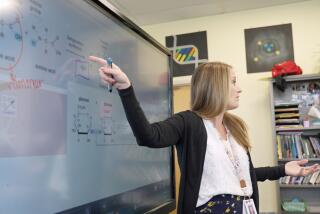An Eye-Popping Problem
- Share via
The symptoms are often clear: youngsters squinting and rubbing their eyes, looking confused during a classroom exercise, bumping into things, putting books too close to their faces, refusing to read.
The causes, of course, are eyesight problems. And if left untreated, they can be serious obstacles to reading and learning.
Many people think that sight troubles are easily discovered and corrected. But teachers and nurses say the path to good vision actually can be tortuous, because of shortages of nurses at some schools, students’ own secrecy and some families’ reluctance to seek help.
For example, George Rosales, a sixth-grader at Mary McLeod Bethune Middle School in South-Central Los Angeles, was getting mediocre grades as he struggled with his eyesight through elementary school.
“Sometimes I couldn’t read my own paper or a book, because it got blurry and I got dizzy,” he said.
He kept his problem to himself until last year. Then he received an examination and free glasses from the Helen Keller International organization. Now, George, 11, says: “I can see better, and I’m doing much better in all subjects.”
Nationwide, nearly 25% of children ages 5 to 18 need eyesight treatment, according to the American Optometric Assn. About 11.5% of teenagers have undetected or untreated vision problems, the association said.
Nearly half of 2,500 pupils at three West Los Angeles elementary schools were recently found to have eyesight problems, said Dr. Jule Lamm, an optometrist in the West Los Angeles Lions Club, a nonprofit service organization that offers free vision screenings.
“A lot of these kids are bright and have potential, and they won’t meet that potential if they have all these problems,” Lamm said.
Private charities such as the Lions Club and Keller International increasingly supplement the efforts of the often-overworked nurses at public schools. At some Los Angeles Unified School District campuses, nurses are present only twice a month, the minimum mandated by law, because schools lack funds for additional staffing.
Typically, nurses in the district screen for vision every three years, said Joyce Jacob, nursing coordinator for schools in the east San Fernando Valley. “It’s time-consuming, but we are very committed to following up,” she said, conceding that many nurses are strapped for time.
Getting families to comply with a referral can be difficult, because the parents may not have the inclination, time or money to do so. And getting children to wear their glasses is another challenge.
At Van Nuys Middle School, school nurse Ann LaBarbera has been tracking a 14-year-old student since his glasses broke in December. Five months later, he remains without a replacement pair, despite several letters the nurse has sent home to his parents.
After summoning the boy to her office recently for an eye test, LaBarbera asked him how he had coped without his glasses? “The teacher has me sit close to the board,” he said.
Sitting on a chair 10 feet from the eye chart, the boy looked like a batter stepping up to the plate. He leaned forward, shuffled his feet and squinted. He got the first line of big letters right but stumbled on the second.
LaBarbera, clearly frustrated, did not go further. She told him she would contact his parents again and hoped to meet with them soon.
In a happier situation, Jeaneth Anthony, a parent of students at Charnock Road Elementary School on the Westside, encourages her three boys to wear the glasses she bought them last month after a Lions Club screening.
As a result, Anthony said, her three sons, ages 11, 9 and 7, are doing better on school assignments.
Before he got eyeglasses, fifth-grader Jaryl Anthony said, he “kept on missing words.” Now he is enjoying school and paying more attention.
Such improvement is not surprising to Shirley Kouffman, principal at Charnock. “Certainly the focus is on reading and student achievement, and we want to make sure that we’re giving all of our students the opportunity to do the best they can,” she said.
The eye test widely used at schools catches the most common problems--nearsightedness and astigmatism, vision care professionals say. But a child who skips words when reading because of an eye tracking problem may be overlooked. The same goes for a farsighted child who can read the eye chart but can barely handle reading a book at desk level.
“Even with a screening process, there are some kids who will fall through the cracks,” the Lions Club’s Lamm said.
Routine screenings are also vital for detecting hearing problems. Good hearing is most essential in the toddler years, because it allows children to decode words and recognize subtle differences in sounds, all critical to learning to read, experts say.
Reina Schaffer, a second-grade teacher at Selma Avenue Elementary School in Hollywood, said she recently referred several students for vision and hearing tests. “If they’re falling behind, those are something to consider,” she said. “Those problems can certainly impede their learning.”
* SOUTHERN CALIFORNIA LIVING: Several books help young readers understand the mysterious workings of nature. One example is “Tornadoes,” which explains the formation of violent storms. E4
More to Read
Sign up for Essential California
The most important California stories and recommendations in your inbox every morning.
You may occasionally receive promotional content from the Los Angeles Times.













